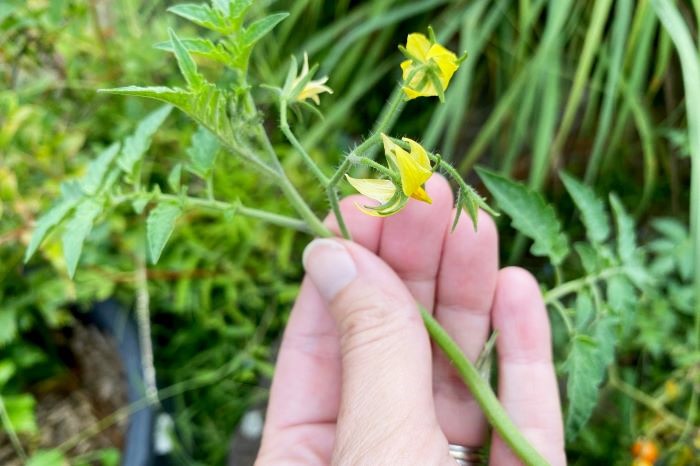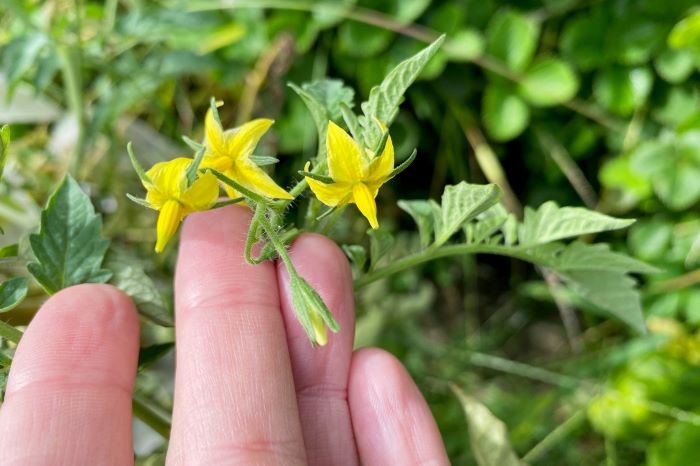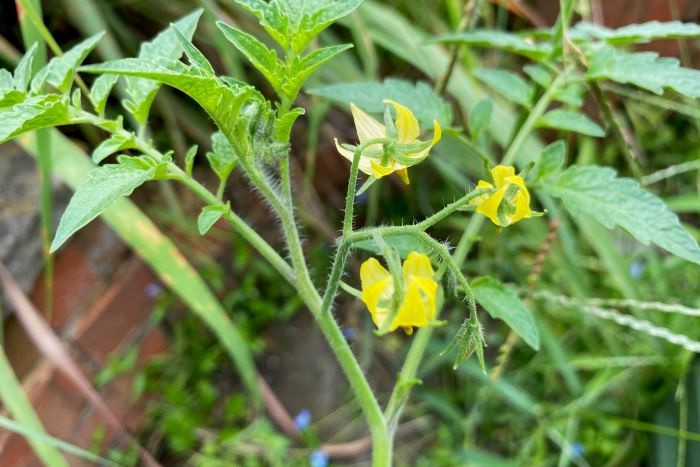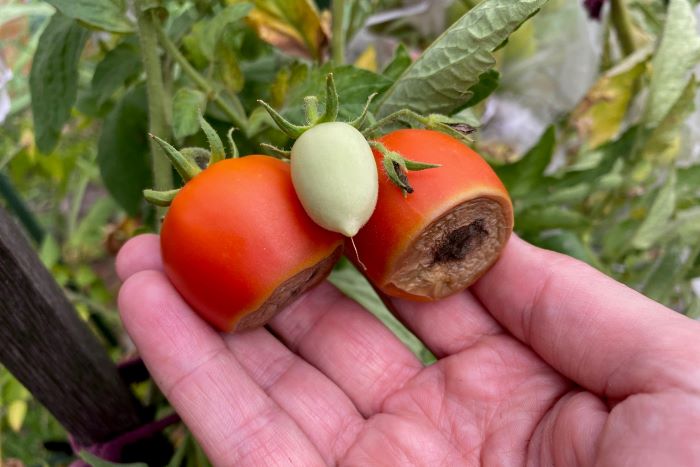Are you frustrated by your tomato plants that don’t seem to produce any fruit, no matter how much they flower? Don’t worry, you’re not alone! Read on to find out the causes and solutions for why your tomato plants are flowering but not producing fruit.

Table of Contents
Why Are My Tomatoes Flowering But Not Producing Fruit?
The most common reasons your tomatoes are flowering but are not producing fruit are lack of pollination, over-fertilization, nutrient deficiencies, insufficient sunlight, water stress, and certain pests and diseases.
Let’s find out more about each cause and how you can fix it for a bumper crop of homegrown tomatoes!
Lack of Pollination
More often than not, your tomato plants are not producing fruit due to a lack of pollination. When your tomato plant flowers, it should produce fruit in just over a month. Tomatoes are self-pollinating plants, meaning the flowers can fertilize themselves with the help of wind or insects.
However, the natural pollination process sometimes fails, and the flowers are not fertilized. This can cause a lack of tomato fruit production, even if the plant has already produced flowers.
When a tomato plant flowers, the female parts of the flower, collectively called the pistil, need to be pollinated by the male part of the flower, the stamen, to produce fruit. Pollination occurs through wind or when insects visit the plant. The movement from the wind or insects causes the tomato plant to vibrate and the pollen to drop and fertilize the tomato plant.
If the flowers on your plant begin to droop and drop off, pollination has not occurred. To solve this issue, you can mimic the buzzing of a bee, insect or the wind by gently shaking your tomato plant which will help release the pollen.

Temperature and Climate Issues
Other factors that can affect pollination are high temperatures and humidity. If your region experiences hot and humid temperatures in the summer above 86 °F (30 °C), pollination will be delayed.
The same problem occurs if the temperature is too cold below 55 °F (13 °C) or if the humidity is too low. If the humidity is low (less than 40%), the pollen can’t stick to the female part of the flower.
The solution to this problem is to hand-pollinate the plants with an electric toothbrush. This should be done in the early morning or at the end of the day when the temperature is at its lowest.
Over-Fertilization
Over-fertilization is a common problem for many tomato growers, and it can lead to several issues, including a lack of fruit production. Over-fertilizing with nitrogen-heavy composts, in particular, can cause a lack of fruit production.
Nitrogen is needed for plants to grow taller and produce green foliage. An overabundance of nitrogen can promote excessive vegetative growth, leading to lush foliage but a lack of fruit development. If you notice that your tomato plants are full of lush-looking vegetation but have no fruit, the soil has too much nitrogen.
To fix the problem, you can apply mulch around the plant, which will help draw out excess nitrogen. Additionally, it is best to apply a well-balanced fertilizer moving forward, one rich in phosphorus and magnesium. I like an organic all purpose fertilizer for growing my tomatoes.
Nutrient Deficiency
Just as too much nitrogen can cause a tomato plant to flower and not produce any fruit, a lack of nutrients has the same effect. To spot a nutrient deficiency, you should look for signs such as yellowing of leaves, stunted growth, and lack of flowers and fruit.
The tomato plant requires a balanced supply of essential nutrients to support vegetative and reproductive growth. When the plant lacks essential nutrients, it can prioritize flower production over fruit development because producing flowers requires fewer resources than developing fruits.
The solution is adding fertilizers designed to treat your particular nutrient deficiency. For example, adding a fertilizer high in phosphorus can address a phosphorus deficiency, while adding a fertilizer high in potassium can address a potassium deficiency.
Soil pH Levels
The most common nutrient deficiencies that can cause tomato plants to flower but not produce fruit are phosphorus, potassium, and calcium deficiencies. Often a nutrient deficiency can occur even if the nutrient is present in the soil if the soil’s pH balance is off.
If the pH level of your soil is not correct, the tomato plant will not be able to absorb the nutrients through its roots. If the nutrients in your soil are well balanced, the soil’s pH level will be between 6.0 and 7.0. You can check this by using a simple soil testing monitor like this one.
If your soil is too acidic, add limestone to it if you need to lower your soil’s pH level by adding sulfur. You can also add organic matter, such as compost, manure, or coffee grounds, to improve soil health and nutrient levels.
Not Enough Sunlight

Insufficient sunlight can cause a tomato plant to produce flowers but no fruit because tomatoes require between 6 and 8 hours per day of sunlight to develop and ripen fruits. Without enough sunlight, the tomato plant cannot produce enough energy through photosynthesis to support fruit development.
When planting your tomatoes, choose a spot that receives a minimum of 6 hours of sunlight daily. If you think a lack of sunlight is behind the lack of fruit, sadly, there is not much to be done. I have found that transplanting tomatoes will fail 9 times out of 10 unless they are still seedlings.
Water Stress
Another reason your tomato plants may not bear fruit after flowering could be caused by either too much or too little water. Before watering your tomato plants, you should check whether the soil is moist or dry. After all, plants that have been over and under-watered eventually look the same.
Too little water can cause tomato plants not to bear fruit because water is essential for many plant processes. These processes are photosynthesis, nutrient uptake, and flower and fruit development. If tomato plants don’t get enough water, they can become stressed, resulting in a lack of flower and fruit development.
Overwatering
Overwatering can cause waterlogging in the soil, which limits root growth and reduces the amount of oxygen available to the tomato plant roots. This can also lead to reduced nutrient uptake, affecting tomato fruit production.
In addition, overwatering can lead to root rot, which damages the tomato plant roots and prevents them from absorbing much-needed nutrients.
To avoid water stress and ensure tomato plants bear fruit, moisten the soil but do not allow waterlogging. Tomatoes generally need about 1 to 2 inches of water per week.
You should monitor the soil’s moisture regularly and adjust the watering frequency. Factors that affect your watering schedule are rainfall, temperature, and humidity.
Inconsistent watering can lead to water stress, so it’s important to maintain a consistent watering schedule.
Pests
Sadly, tomatoes are a firm favorite feat for many common garden pests. A pest infestation can cause your tomato plant not to produce fruit for several reasons.
One of the most common ways is by feeding on the leaves, stems, or fruits of the plant, which can affect the overall health of the plant. This can lead to decreased flower and fruit production, as the plant may not have the resources it needs to produce fruit.
In addition, some pests can carry diseases that can affect fruit production. Several pests can cause stunted growth, yellowing of leaves, and reduced fruit production.
The most common pests on tomatoes are aphids; potato aphids, in particular, cause the blossoms to drop. Fortunately, aphids are relatively easy to control. Just spray the plants with a mixture of dishwashing soap and water after thoroughly spraying them with the garden hose.
Other pests causing your tomato plant to flower but not produce fruit are hornworms, leaf miners, and root-knot nematodes.
You can remove hornworms by hand (I don’t recommend this if you are squeamish), while leaf miners can be stopped by applying row covers. Sadly, pests like root-knot nematodes can only be dealt with by destroying the plants though you can fix the problem for the future by introducing beneficial nematodes like these.
Diseases

When a tomato plant becomes diseased, it often stops bearing fruit. Plant diseases that affect the tomato plant roots can impair the plant’s ability to absorb water and nutrients, resulting in stunted growth and reduced flower and fruit production.
Similarly, a disease that affects the leaves can reduce the plant’s ability to photosynthesize, limiting its ability to produce energy and resources needed for tomato fruit production.
Several diseases can affect the production of tomato fruit, the most common being verticillium Wilt, fusarium wilt, tomato big bud, and blossom-end rot.
Prevention is better than a cure when it comes to tomato plant diseases. To prevent diseases from affecting fruit production, you should promote plant health and prevent the spread of pathogens.
You can do this by using disease-resistant tomato varieties, practicing good sanitation, rotating crops, and using organic fungicides such as neem oil or other treatments as necessary.
Further Reading:
- Tomato Seedling Leaves Turning Yellow: Causes and Solutions
- Tomatoes Rotting at the Bottom? (Blossom End Rot Explained)
- 7 Reasons Your Tomatoes are Small (With Solutions!)
- How To Grow Tomatoes In Pots
- Best Tomatoes To Grow in Pots
- Determinate and Indeterminate Tomatoes: What Are They?
- How to Ripen Green Tomatoes Indoors: Five Easy Methods That Work
